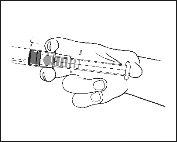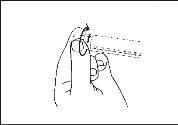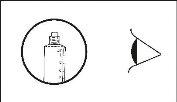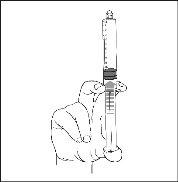
SUGAMMADEX AGUETTANT 10 mg/ml Injectable Solution in Pre-filled Syringe

How to use SUGAMMADEX AGUETTANT 10 mg/ml Injectable Solution in Pre-filled Syringe
Introduction
Package Leaflet: Information for the Patient
Sugammadex Aguettant 10 mg/ml solution for injection in a pre-filled syringe
Sugammadex Aguettant 50 mg/ml solution for injection in a pre-filled syringe
Read all of this leaflet carefully before you are given this medicine because it contains important information for you.
- Keep this leaflet, you may need to read it again.
- If you have any further questions, ask your anaesthetist or doctor.
- If you get any side effects, talk to your anaesthetist or doctor, even if you think they are not related to the medicine. See section 4.
Contents of the pack
- What is Sugammadex Aguettant and what is it used for
- What you need to know before you are given Sugammadex Aguettant
- How Sugammadex Aguettant is given
- Possible side effects
- Storage of Sugammadex Aguettant
- Contents of the pack and other information
1. What is Sugammadex Aguettant and what is it used for
What isSugammadex Aguettant
Sugammadex contains the active substance sugammadex.
Sugammadex is considered a Selective Relaxant Binding Agentas it only works with specific muscle relaxants, rocuronium bromide or vecuronium bromide.
What Sugammadex Aguettant is used for
If you need to have an operation, your muscles must be completely relaxed, which makes the operation easier for the surgeon. To achieve this, you will be given medicines during general anaesthesia to relax your muscles. These are called muscle relaxants, and examples include rocuronium bromide and vecuronium bromide. Since these medicines also block the muscles used for breathing, you will need help breathing (artificial respiration) during and after the operation until you can breathe on your own again.
Sugammadex is used to speed up the recovery of your muscles after an operation so that you can breathe on your own again sooner. It does this by binding to rocuronium bromide or vecuronium bromide in your body.
Sugammadex can be used in adults when rocuronium bromide or vecuronium bromide is used and in children and adolescents (between 2 and 17 years) when rocuronium bromide is used for moderate muscle relaxation.
2. What you need to know before you are given Sugammadex Aguettant
Do not receiveSugammadex Aguettant
Tell your anaesthetist if this applies to you.
Warnings and precautions
Talk to your anaesthetist before you are given sugammadex
Children and adolescents
This medicine is not recommended for children under 2 years of age.
Other medicines andSugammadex Aguettant
Tell your anaesthetist if you are taking, have recently taken or might take any other medicines.
Sugammadex may affect other medicines or be affected by them.
Some medicines reduce the effect ofSugammadex Aguettant
It is especially important that you tell your anaesthetist if you have recently taken:
- toremifene (used to treat breast cancer).
- fusidic acid (an antibiotic).
Sugammadex Aguettantmay affect hormonal contraceptives
- Sugammadex may make hormonal contraceptives - such as the "Pill", vaginal ring, implants or an Intrauterine Hormonal Device (IUD-h) - less effective because it reduces the amount of progestogen hormone that reaches you. The amount of progestogen lost due to the use of sugammadex is approximately the same as that lost when you miss a contraceptive pill.
Effects on blood tests
Generally, sugammadex does not affect laboratory tests. However, it may affect the results of a blood test when progesterone hormone levels are measured. Talk to your doctor if your progesterone levels need to be tested on the same day that you receive sugammadex.
Pregnancy and breastfeeding
Tell your anaesthetist if you are pregnant, think you may be pregnant or are breastfeeding.
It may still be given to you, but this needs to be discussed beforehand.
It is not known whether sugammadex can pass into breast milk. Your anaesthetist will help you decide whether to stop breastfeeding or avoid treatment with sugammadex, considering the benefit of breastfeeding to the baby and the benefit of sugammadex to the mother.
Driving and using machines
Sugammadex has no known influence on the ability to drive and use machines.
Sugammadex Aguettantcontains sodium
Sugammadex Aguettant 10 mg/ml
Each 10 ml pre-filled syringe contains 42.6 mg of sodium (main component of table/cooking salt).
This is equivalent to 2.1% of the maximum recommended daily intake of sodium for an adult.
Sugammadex Aguettant 50 mg/ml
Each 5 ml pre-filled syringe contains 30.8 mg of sodium (main component of table/cooking salt).
This is equivalent to 1.5% of the maximum recommended daily intake of sodium for an adult.
3. How Sugammadex Aguettant is given
Sugammadex will be given to you by your anaesthetist, or under the supervision of your anaesthetist.
Dose
Your anaesthetist will calculate the dose of sugammadex you need based on:
- your weight
- the amount of muscle relaxant that is still affecting you.
Sugammadex Aguettant 10 mg/ml
The 100 mg/10 ml pre-filled syringe is more suitable for children and adults who weigh less than 50 kg.
For high doses or weights over 50 kg, other presentations or formulations are available.
The usual dose is 2-4 mg per kilogram of body weight for adults and for children and adolescents between 2-17 years. A dose of 16 mg/kg can be used in adults if urgent recovery of muscle relaxation is needed.
How Sugammadex Aguettant is given
Sugammadex Aguettant will be given to you by your anaesthetist. It is injected once into a vein (intravenously).
If you are given moreSugammadex Aguettantthan recommended
Since your anaesthetist will be carefully monitoring the situation, it is unlikely that you will be given too much sugammadex. But even if this happens, it is unlikely to cause any problems.
If you have any further questions on the use of this medicine, ask your anaesthetist or doctor.
4. Possible side effects
Like all medicines, this medicine can cause side effects, although not everybody gets them.
If these side effects occur while you are under anaesthesia, your anaesthetist will detect and treat them.
Common (may affect up to 1 in 10 people)
- Cough
- Respiratory difficulties that may include cough or movements as if you were awake or taking a breath
- Light anaesthesia – you may start to wake up, so you may need more anaesthetic. This may cause you to move or cough at the end of the operation
- Complications during the procedure, such as changes in heart rate, cough or movement
- Decrease in blood pressure due to the surgical procedure
Uncommon (may affect up to 1 in 100 people)
- Difficulty breathing due to muscle spasms in the airways (bronchospasm) that occur in patients with a history of lung problems
- Allergic reactions (hypersensitivity to medicines) - such as rash, skin redness, swelling of your tongue and/or pharynx, difficult breathing, changes in blood pressure or heart rate, which sometimes result in a severe drop in blood pressure. Allergic reactions or severe allergic reactions can be life-threatening.
Allergic reactions were reported more frequently in healthy conscious volunteers.
- Reappearance of muscle relaxation after the operation.
Frequency not known
- When sugammadex is administered, a significant slowing of the heart can occur, which can even lead to cardiac arrest
Reporting of side effects
If you experience any side effects, talk to your anaesthetist or doctor, even if you think they are not related to the medicine. You can also report side effects directly through the Spanish Medicines Monitoring System for Human Use: www.notificaRAM.es. By reporting side effects, you can help provide more information on the safety of this medicine.
5. Storage of Sugammadex Aguettant
Storage will be the responsibility of healthcare professionals.
Keep this medicine out of the sight and reach of children.
Do not use this medicine after the expiry date which is stated on the carton, blister and syringe label after “EXP”. The expiry date is the last day of the month shown.
Do not freeze.
Store the syringe in the outer packaging to protect it from light.
Keep the pre-filled syringe in its blister pack until use.
After opening, the medicine must be used immediately.
Any pre-filled syringe, even if partially used, must be disposed of properly after use.
Medicines should not be disposed of via wastewater or household waste. Ask your pharmacist how to dispose of medicines no longer required. This will help protect the environment.
6. Contents of the pack and other information
What Sugammadex Aguettant contains
- The active substance is sugammadex
Sugammadex Aguettant 10 mg/ml
Each millilitre of solution for injection contains sugammadex sodium equivalent to 10 mg of sugammadex.
Each 10 ml pre-filled syringe contains sugammadex sodium equivalent to 100 mg of sugammadex.
Sugammadex Aguettant 50 mg/ml
Each millilitre of solution for injection contains sugammadex sodium equivalent to 50 mg of sugammadex.
Each 5 ml pre-filled syringe contains sugammadex sodium equivalent to 250 mg of sugammadex.
- The other ingredients are sodium chloride, hydrochloric acid or sodium hydroxide (for pH adjustment) and water for injections.
Appearance ofSugammadex Aguettantand pack contents
Sugammadex Aguettant 10 mg/ml
Sugammadex Aguettant is a clear, colourless to slightly yellow solution for injection in a 10 ml polypropylene pre-filled syringe, with a transparent, graduated, self-adhesive label (subgraduations of 0.5 ml from 0 to 10 ml). Each pre-filled syringe is packaged in a transparent blister.
Sugammadex Aguettant 50 mg/ml
Sugammadex Aguettant is a clear, colourless to slightly yellow solution for injection in a 5 ml polypropylene pre-filled syringe, with a transparent, graduated, self-adhesive label (subgraduations of 0.2 ml from 0 to 5 ml). Each pre-filled syringe is packaged in a transparent blister.
Cartons of 10 pre-filled syringes.
Marketing authorisation holder and manufacturer
Laboratoire Aguettant
1, rue Alexander Fleming
69007 Lyon
France
Local representative:
Aguettant Ibérica S.L.
Baldiri Reixac, 4-8, Torre I, 4º
08028 Barcelona
Date of last revision of this leaflet 08/2023.
------------------------------------------------------------------------------------------------------------------------
This information is intended only for healthcare professionals:
Please prepare the syringe carefully as follows
The pre-filled syringe is for single patient use only. Discard the syringe after use. DO NOT REUSE.
The content of an unopened and undamaged blister is sterile, and the blister should not be opened until the syringe is ready for use.
The product should be inspected visually for particles and colour changes before administration. Only a clear, colourless to slightly yellow solution, free of particles or precipitates, should be used.
The product should not be used if the tamper-evident seal of the syringe is broken.
Do not use this medicine if you notice visible signs of deterioration.
The outer surface of the syringe is sterile until the blister is opened. The blister should not be opened until use.
When handled aseptically, this medicine can be placed in a sterile field once it has been removed from the blister.
The administration volume should be calculated taking into account the appropriate dosage.
- Remove the pre-filled syringe from the blister.
|
|
|
|
|
|
|
|
- Connect the syringe to the vascular access device using a luer/luer lock system. Push the plunger slowly to inject the required volume. Administer the product according to the appropriate route of administration.
The pre-filled syringe is not suitable for syringe pumps. The pre-filled syringe is a ready-to-administer product.
Do not use any syringe that has been damaged or handled without respecting the conditions of sterility.
Disposal of unused medicine and all materials that have come into contact with it will be carried out in accordance with local regulations.
- Country of registration
- Active substance
- Prescription requiredYes
- Manufacturer
- CompositionCLORURO DE SODIO (8,5 mg/ml mg), HIDROXIDO DE SODIO (E 524) (7-8 pH mg)
- This information is for reference only and does not constitute medical advice. Always consult a licensed doctor before taking any medication. Oladoctor is not responsible for medical decisions based on this content.
- Alternatives to SUGAMMADEX AGUETTANT 10 mg/ml Injectable Solution in Pre-filled SyringeDosage form: INJECTABLE, 100 mgActive substance: sugammadexManufacturer: Merck Sharp & Dohme B.V.Prescription requiredDosage form: INJECTABLE, 100 mgActive substance: sugammadexManufacturer: Merck Sharp & Dohme B.V.Prescription requiredDosage form: INJECTABLE, 100 mg/mlActive substance: sugammadexManufacturer: Accord Healthcare S.L.U.Prescription required








